Honey has been an integral part of the human story ever since the first humans began gathering it from beehives about 9,000 years ago. Is it possible that for all those years we have been eating bee poop?
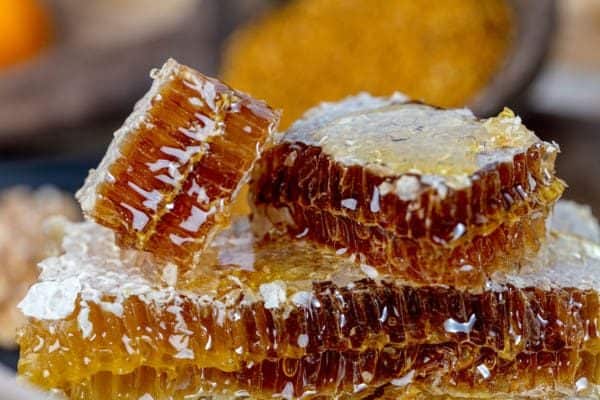
Is honey bee poop? No, honey is not bee poop. If fact honey comes from the other end. Initially ingested as nectar from flowers into a special honey stomach bees pass the nectar to each other in the hive converting the nectar to honey. Bees do poop but it is not honey.
Its powers of healing were discovered long before the advent of modern medicine and it was used to cure ailments and treat wounds in ancient Africa, Asia and Europe.
Thousands of years later, archaeologists would discover honey stored in the tombs of the Pharaohs which was still edible due to having been kept water and air-tight.
But what exactly is this wondrous substance which we owe to the most hardworking and fascinating creatures in existence and just how is it produced?
Could it possibly be a by product of their digestive process, i.e., waste matter? In other words, is honey actually bee poop?
Here we will be discussing all you need to know about how these marvellous little insects produce the one substance most of us have come to know, love and rely on and in so doing, solve the mystery of its true identity.
What do Bees Eat?
We know that honey is produced by bees using certain food items they eat. Hence in our quest to find out how it is made and what it really is, we‘re going to have to take a look at their favorite food items.
Surprisingly, the diet of these black and yellow workaholics is rather more varied than we might believe as can be seen from some of the options provided below:
Pollen
Pollen presents in the form of minute particles produced by a flower’s male reproductive organ, the stamen. Pollen must be transferred to a central tube with protruding antennae known as the pistil, of that same flower, or another, which also contains the female reproductive organ of the flower, i.e, its ovary.
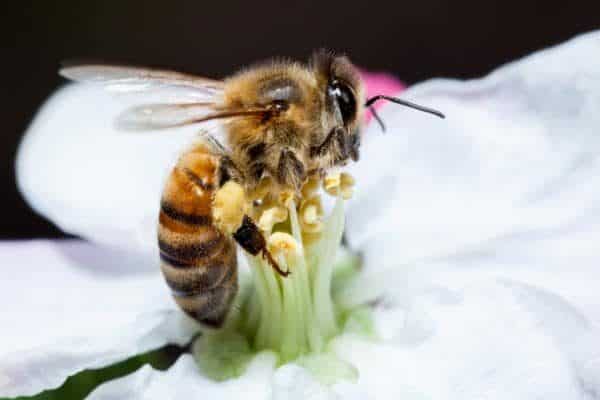
We have a post that breaks down this process “How bees pollinate” in detail. It is really why bees are so important to our planet.
In addition to kickstarting the reproductive process, pollen also serves as a source of protein, fat, minerals, and vitamins for bees which also feed it to larvae as well.
It is especially important since it plays a role in enabling them to lay eggs, produce royal jelly and ensure the survival of the hive as a result.
Nectar
A saccharine, watery syrup produced by flowers by means of glands referred to as nectaries. Nectar may be considered to be a currency of sorts offered by plants to reward bats, bees, birds and butterflies for spreading their pollen.
To ensure those tiny spores get spread amongst as many flowers as possible, most plants have their nectaries located in such a way that pollinating agents end up getting smeared with pollen before they can get to the sugary treat they have to offer.
Nectar serves as a source of carbohydrates as well as minerals which are essential for the sustenance bees require in order to survive and complete the daily tasks which enable the hive to run like clockwork.
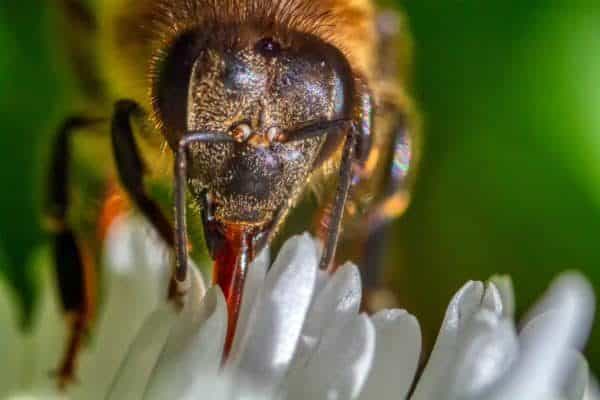
It is also used by bees to produce honey, the thick, golden goo which has become a staple on our tables by means of a process which is discussed in the next section (not subsection) below.
Additional Dietary Options
Fruits: The overwhelming fondness bees possess for anything sweet means they are not averse to helping themselves to a refreshing drink of fruit juice every now and again.
They do so by interesting their proboscises into a piece of fruit with broken skin, and sucking out the sweet fluid.
Examples of fruit, they are known to enjoy include lychees, apples, grapes, peaches, pears and strawberries.
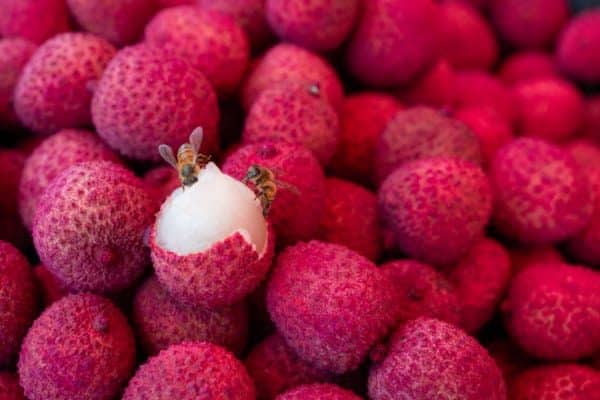
Soda: Humans are by no means the only species who have a fondness for soda: bees do too. No surprise since it comes packed with loads of palate-pleasing sugar. If a can of Fanta is left unattended in your garden, it may attract a curious apian or two determined to get a proboscis-full of orange fizz.
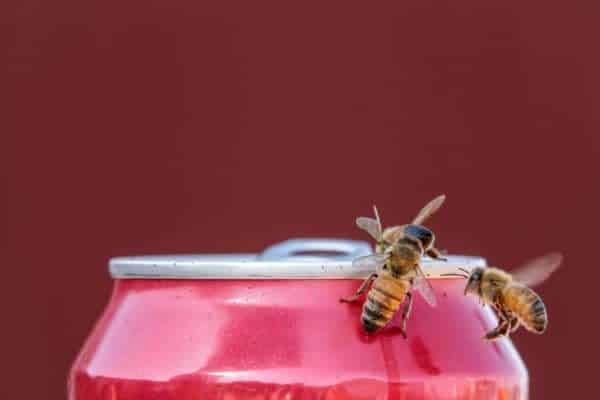
Sweetened Water: This mixture of sugar and water reminds bees of one of their favorite things in the whole wide world – nectar.
As a result, beekeepers may rely on it to tide their little fuzzy friends over until the good times roll around again and there’s an abundance of food once more.
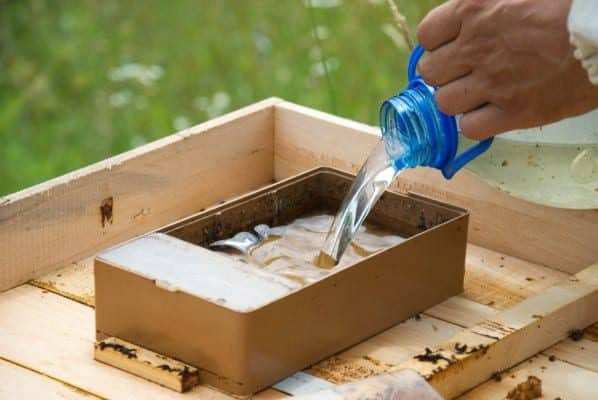
However, it is worth noting that sugar water lacks the nutrients which come with the real thing and is as a result, occasionally described as the apian equivalent of fast food.
How is Honey Made?
The honey-making process starts with a worker bee collecting nectar from a flower which it stores in a special honey stomach. On arrival at the hive, the bee hands over its harvest to another worker before flying off to gather some more.
The bee that has received the nectar in the hive will now pass the nectar between her co-workers. As the nectar passes through multiple mouths of bees, they chew on the nectar they are adding enzymes that break the sugar in the nectar into simpler components.
When the sugars have broken down and the moisture content has reduced significantly the bees deposit the nectar in cells in the hive’s honeycomb.
Finally, the worker must get most of the remaining water contained in the nectar to evaporate. This is done by bees fanning its wings in the hive. This process will reduce the water content of the nectar from approximately 70% to just under 20%. The end result is the amber or golden, ambrosia known to us as honey.
Now satisfied with its handiwork, the bee promptly seals the cell with a layer of wax to protect it from moisture and microbes.
All You Need to Know About Bee Poop
Now you’ve breathed a huge sigh of relief at discovering just how honey is made and are secure in the knowledge that you won’t have to give up your favorite sweetener and breakfast spread, you probably still have a few burning questions on your mind.
Maybe you are wondering if bees really poop in addition to where and when. We’ve covered each of them in detail, below.
Yes, Bees Do Poop
As a matter of fact, these marvelously productive little creatures do. However, being remarkably fastidious, all such business is handed outside the hive – even if they have to hold it in all winter (a feat they actually accomplish – for the most part).
Efficient worker bees also get to take care of bee poop produced by their fellow hive dwellers who never get to go anywhere, i.e., the queen, drones and larvae.
Bee poop is yellow and tends to stick to surfaces with a vengeance making it rather difficult to get rid of. That said, a 30-minute soak followed by a vigorous scrub should do the trick.
Where do they Poop?
In addition to taking great care not to go to the loo indoors, bees also take care not to do their business too close to home.
As a result, they prefer to go to the toilet at a distance away from the hive. Once they’ve flown far enough, any surface is fair game: your car, your laundry, and even those painstakingly nurtured blooms in your garden.
Bee Diarrhea
Yes, our little fuzzy friends in black and yellow can suffer from bouts of diarrhea. This condition is frequently due to two main causes:
The presence of excess fiber in the gut: One of bees’ main tasks during those winter months when they remain locked away involves keeping the hive warm.
In order to ensure they are adequately equipped to prevent the temperature of their home from dropping beyond tolerable levels, bees must top up their energy by eating. However, honey does contain fiber which accumulates in their stomachs since they do not pass waste while ensconced in the hive.
If a bee has an excessive amount in its gut, it will be at risk of diarrhea which may be triggered when it drinks some water.
A parasitic infection: Another means by which bees might find themselves hit with a bout of diarrhea is a result of getting infected by Nosema parasites.
When this occurs, bees may find themselves unable to abide by the hive’s strict hygiene policy and may even pass stool on its honeycombs. When workers attempt to get rid of the stool, they too will become infected in turn, resulting in a widespread outbreak of dysentery within the hive.
A Nosema infection may also result in a reduction in the lifespan of the members of the hive and may also cause infertility.
The chances of a hive’s survival depends on the severity of the infection and it may be wiped out entirely or recover with the advent of warmer weather due to bees being able to go to the toilet outside.
It is worth noting that there are two strains of Nosema: Nosema apis and Nosema ceranae.
Infections involving the former commonly occur during winter while those involving the latter are more likely to occur during summer.
The Wrap Up
Is honey bee poop? Thankfully, it isn’t. It’s merely another incarnation of nectar, albeit with less water, and sugars that have been broken down into simpler compounds.
Best of all, it’s also produced and stored in remarkably hygienic conditions, with any waste material on and around the premises being kept to a minimum.
And with its ability to tantalize our taste buds, care for our hair and skin and even resist decay for thousands of years, it is certainly one of the most remarkable marvels of our planet as are the hardworking, longsuffering creatures which produce it.
